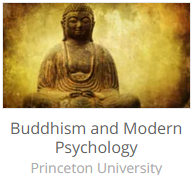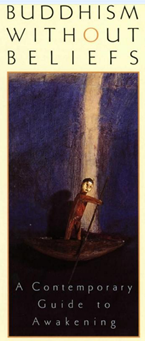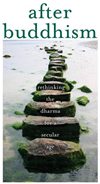Secular Buddhism
Some interesting concepts on Buddhism from Coursera class I have attended and study of modern texts.
Reference material
The class 'Buddhism and Modern Psychology' is a low level introductory to Buddhism that is taught without religion of any kind. It is a great starting point if your interested in the basic Buddhist beliefs without any of the later trappings of super natural beliefs like rebirth and flying etc.
The two books from Steven Batchelor reflect the thoughts of a person that has devoted his life to a complete understanding of Buddhism and finally concluded that he is an atheist. 'Buddhism without Beliefs' gives a good understanding of the concepts introduced in the Coursera class and is recommended. The other book 'After Buddhism' is the history of Buddhism in detail and frankly more information than I was really looking for.
An internet friend of mine Dallen Nakamura sent me a link to an interesting article he wrote covering Buddhism in general and Secular Buddhism. You can find it here:
Buddhism: A look into the beliefs, Practices & History.
Thank you Dallen.
My writing on the subject.
The Self - My thoughts on the Self/Not-Self
Science and Buddhism - Similarities between them
My Mothers Self- A personal example of a loss of self
 The Buddha’s theory on the self is contained in his Discourse on the Not Self, it was the sermon given after the principal of the Four Noble Truths. In it he makes the case for Anatman (non-Self) by reasoning about the constitutes that must make up the self and then reasoning that these cannot be true. He orders these constitutes into five aggregates that must then make up everything there is to be know about a person. They are:
The Buddha’s theory on the self is contained in his Discourse on the Not Self, it was the sermon given after the principal of the Four Noble Truths. In it he makes the case for Anatman (non-Self) by reasoning about the constitutes that must make up the self and then reasoning that these cannot be true. He orders these constitutes into five aggregates that must then make up everything there is to be know about a person. They are:
- Form – Anything about the physical body. The size of the appendages, the curvature of the limbs, the color of the eyes and the hair etc.
- Feeling – The sensations of the mind such as: Pleasant, unpleasant, love, understanding, confident receptivity, accepting etc.
- Perception – These are the channels that the outside world enters the Self. They are Sight, sound, touch, taste, and smell.
- Mental Formations – Emotions, desires, volition, shame, diligence and others. They are creations of the mind alone and do not exist outside of the mind.
- Consciousness – Awareness, of the other four aggregates
Argument Against the Self
In his argument the Buddha examines each of the five aggregates to determine if it could be a part of Self by applying a test of Permanence and Control. He reasons that the Self must be stable and continuous throughout the life of a person and the Self must be in control of that person’s aggregate properties. The Buddha then examined each of the aggregates in turn.
Form – This is not a permanent property because it changes from birth to death in dramatic ways. It is also not under control of the Self otherwise the Self could, for example, demand the re-growth of a missing limb or a change to the color of the eyes. The Form therefor not be part of the Self.
Feelings – The Self does not have control of feelings because they arise unbidden and fade with time. Feelings are impermanent, are not under control and therefore cannot be part of the Self.
Perception – The Self perceives color as tones and weight, it perceives sound as pitch and timber, touch as rough and smooth and smell as pleasant and disgusting. These perceptions change minute by minute. A perceived color is different when the light changes, a sound may become muffled, and you may become sick of a perfume and find it disgusting. So these perceptions do not persist though time. The self cannot assign the property of color to an object it can only react to it. A sound cannot be changed by the Self it can only hear it. The Self has no control over perceptions and they are also impermanent so they cannot be part of the Self.
Mental Formations – These are the dispositions or fabrications of the mind. The mind has the ability to create structures such as ignorance and knowledge, language, the ability to discern objects in time and space, attention of events, desire to act, and Free Will. The Buddha would point out that these fabrications come and go in the mind. You can learn a new language and lose a desire to act in a certain way so they are not permanent through time and therefore cannot be part of the Self. He would also argue that the formations arise and disperse without control of the Self so Mental Formations cannot be a constitute of the Self.
Consciousness - Considered to be not the CEO or controller of the other four aggregates but the one that is being controlled by the self. It has been described as the aggregate that is aware of the properties of Perception. It is consciousness of eye, of ear, touch, taste and smell. Since Consciousness must be aware of the other four aggregates and each of these has been shown to be not part of the Self then consciousness cannot be part of the self.
Each aggregate was thus analyzed and dismissed by the phrase:
This is not mine, this I am not, this is not myself
Additional Arguments Against the Self
Modern Psychology shows that unconscious forces control the illusion of the self to a large extent and several experiments have shown control over the Self by evolutionary forces. For example; Split brain experiments show that it is possible to create two ‘Self’s within one brain. Each side has its own set of Self illusions, likes and dislikes.
A PBS documentary on the Brain included a section on phantom arm phenomena. A patient who had undergone a split brain operation for epilepsy was examined. The operation was successful but she had no control over her left arm. It wasn’t a dead limb but was actively moving under exclusive control of the right side of the brain. Since the right side has no speech capability the woman could not report verbally to the examiners about what was happening to her arm.
Subliminal information has been embedded in advertisements for many years as a way to pressure the buying habits of the public. As well as subliminal information delivery several experiments have shown the inability of the mind to be consistent in memory’s and fact recall. Recall seems to be an ad hoc process with unusually poor reliability.
Science and Buddhism
 The question is: Does modern science lend support to Buddhist ideas about the human predicament?
The question is: Does modern science lend support to Buddhist ideas about the human predicament?
The answer is – Yes. Science builds on the original ideas of the Buddha.
The concept of suffering is well defined in Buddhism but only recently ‘discovered’ by evolutionary scientists. Suffering, as defined is a want of physical or mental satisfaction to a perceived need. Suffering may be a minor irritant, such as the felt need for regress for a slight inflicted by another member of your community, or important, like the immediate need for water. The Buddha taught that the ability to recognize both of these types of suffering arise from the human mind and that it’s possible to control the automatic reaction to them. A person that recognizes these sufferings for what they are, creations of the mind, can methodically deal with them as they arise. Rather than striking out immediately to an insult, you many want to formulate a response that makes better use of your resources for maximal effect. When the suffering is a physical need for water you can allow that to take precedence over minor suffering to keep yourself healthy.
The study of evolutionary psychology in just the last few years has been able to make it clear that these responses are a result of the mind being modified by evolution over millions of years. For example: The perceived slight from an evolutionary perspective can be understood as a challenge to your place in the community, and therefore right to mate successfully. Keeping the response to this challenge in balance will allow you to protect your genetic future with the best prospects of success and still maintain your place in the community.
The physical need for water can be traced to changes in the salinity level of the fluids surrounding the neurons in the brain and their direct response to it. Evolutionary physiology recognizes these responses as evolutionary adoptions to keep the organism healthy and able to fulfill its role as an agent of progeneration.
With the scientific knowledge of the origins of these elements of suffering an individual is better able to balance the response.
Its seems that the Buddha was able to come to these conclusions about the predicament of human nature 2,500 years before science arrived at the same conclusions. The Buddha was able to do this by simple, direct, consideration of the problem. Modern science uses the tools of modernity, such as neural action response and fMRI, to come to the same conclusions.
The Question is: Does modern science lend support to Buddhist ideas about the human mind?
The answer is - Yes to some extent.
The Buddha in his discourse on the Not-Self, taught that the mind consists of five ‘bundles’ or aggregates. They are Form, Feeling, Perception, Mental Formations and Consciousness. He then pointed out that for these five to make up the Self the collection would have to exhibit both permanence and control over the body. He examines each in turn rejects it as part of the Self.
This actually seems to be a weak proof for the hypothesis of the Not-Self. For example, the proposal that Self requires permanence ignores the possibility of a Self that is modified over time. The Buddha uses this same argument when he says that you are not exactly the same person now that you were when you’re a baby. He accepts this as proof of impermanence but that alone doesn’t seem to be enough to rule out Self. Why must complete, static non-changing be a hallmark of the Self. The Buddha points out that you have no control over the Form, Feeling, Perception and Mental Formations of the mind but then goes on to propose a way that, through understanding of the root cause of suffering, the Mental Formations of the mind can be accommodated. This seems like a measure of control to me.
Modern science can accept the classification of the major functions of the mind into the five bundles but after that goes about disproving The Self in a different way. Neurological Science has learned how the individual components of the brain operate to a fine detail. It’s now known how ions flow in and out of neuron cell membranes, how the neurons form new connections for long term memory creation, how they communicate with each other over several trillion connections and how neural transmitters are created, released and recovered.
Evolutionary psychology has demonstrated that many of the functions of the brain are designed to fool the individual into surviving situations in spite of logic. The built-in evolutionary ability to find faces in noise and thereby to see the lion in the bush even when there is none shows a positive outcome of this type of deception.
Nowhere in the scientific detailed study of the brain has there been any hint of any operation that is not strictly deterministic. There cannot be found an agent of Free Will and therefore no ‘Self’ seems the most likely outcome.
“There is no ghost in the machine”
So modern science and the Buddha came to an agreement on the Non-Self at least. From there as Buddhism veers off into religion and science delves more and more into the details of the brain the two seem destined to never again meet in agreement.
I consider the discourse on the Not-Self the single triumph of logic contained in Buddhism.
My Mothers Self
I had a very real collision with the lack of self. Not my own but my mother’s self.
My mother was 97 years old and living in a full care facility 800 miles away from me. The facility was staffed by knowledgeable, wonderful people who added to my mother’s final days. They could give her the professional attention that I could not.
My wife and I traveled to see her every few weeks and could sense the changes in her each time. She had several TIA’s (small strokes) that made perceptible changes in her personally. During one of the last visits I was setting alone with her chatting about her early life and what it was like to be a flapper in the roaring ‘20s and what she could tell me about her and my father’s days early in their marriage that produced me. She told me many things in the distant past and things that happened in the last few days. She was fully alert.
We were laughing and reminiscing and having a good time when she suddenly asked me “Where is Jim”? I thought she was having trouble seeing me because of her failing eyesight and assumed that she thought I might have stepped out of the room. I told her “I’m right here mom”. She responded with “No the other Jim that lives in California with his wife. He is my son. I don’t know about you”. I tried to reassure her that I was her son from California and that the woman that was with me earlier that day was my wife. I asked her if she recognized me and she said she did but insisted that there was another Jim that was her real son and that he must still be in California. She was upset that this impostor Jim was staying with the real Jim’s wife and wondered why she would do such a thing. I could never convince her that I was her son.
Each time we visited she never got over the idea that I was an impostor and always felt bad that her son, the real California Jim, never came to see her. She died never again seeing her real son.
My mother must have been suffering from Capgrss delusion from the descriptions I have seen of it. I now understand that she could see me, smell me, hear me, and touch me but should could not associate the emotions she remembered from giving birth to me and living with me for so many years with the present senses her body felt. She was experiencing the emptiness of son-ness.
My conclusion is that the perception of son-ness, tree-ness, rose-ness and all the other ‘ness of objects in the world is an important attribute of them not a false property that should be eliminated by Buddhism practice.
Obtaining emptiness is a true loss not a gain.



